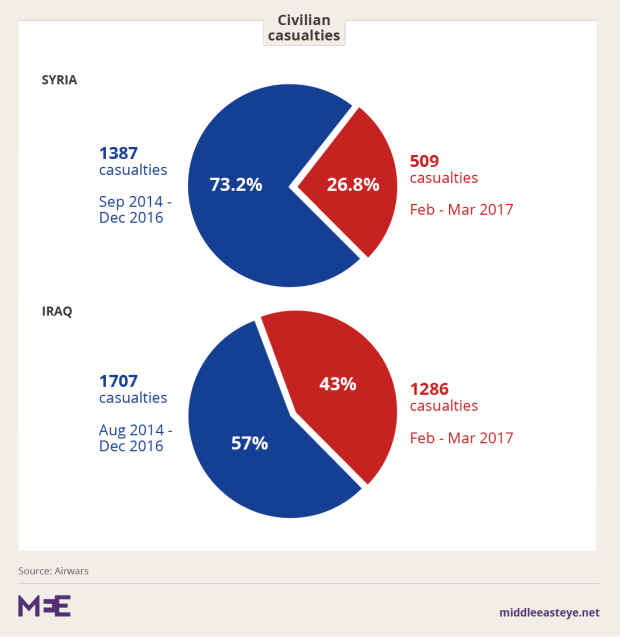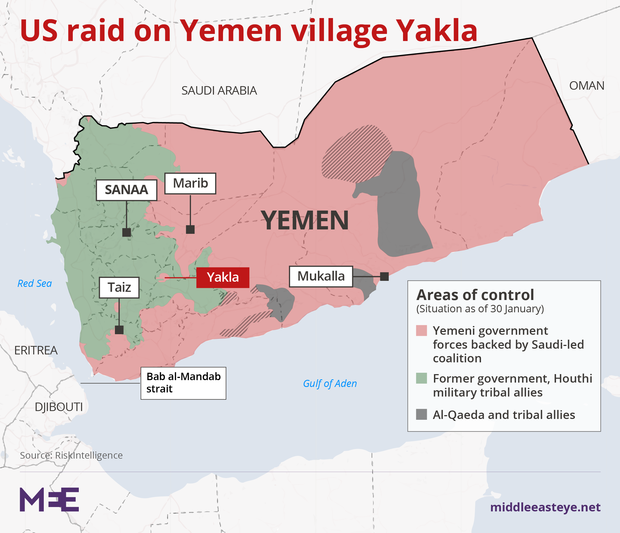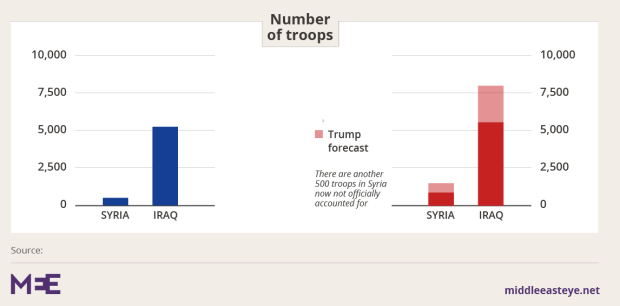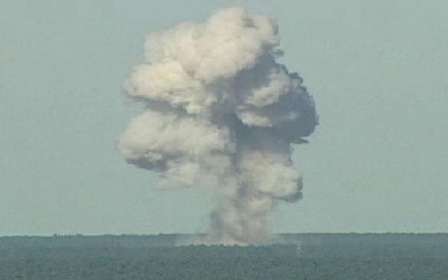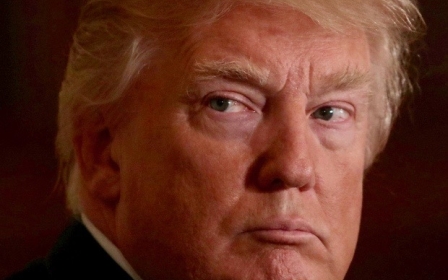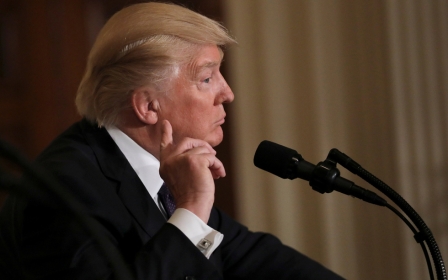Trump's war: Eight ways president has flexed military muscle
Donald Trump has made major changes to the US military presence in the Middle East since stepping in the White House two months ago, and could soon increase the US war footprint even more, MEE analysis of data shows.
March, the second month of Trump's presidency, was the deadliest for civilians in Iraq since 2014, when a US-led coalition began a campaign against the Islamic State group in Iraq and Syria.
Trump is also planning on increasing the number of US troops in Iraq, Syria and Afghanistan, while stepping up the number of air strikes in Yemen.
MEE collected and analysed data on Trump's war footprint.
1. Trump is 'bombing the s*** out of ISIS' ...
During his presidential campaign Donald Trump accused president Obama of being too soft on IS, promising he would "bomb the s*** out of ISIS". He is very much doing so.
In March, the US led coalition dropped 3,878 munitions on Iraq and Syria, more than at any other point since the military operations started in August 2014, according to data released by the Air Forces Central Command (AFCENT).
The number of bombs dropped in anti-IS operations in January and February were already at record levels. In March, under Trump's presidency, the coalition used 636 weapons more than in November 2015, Obama's busiest month.
2. Trump is hitting Syria more...
In January, when power transitioned from Obama to Trump, the coalition dropped a record number of bombs on Syria, although Obama was mostly responsible for the record number of attacks.
Since February, the US-led coalition under Trump conducted more than twice as many air strikes than Obama's monthly average in Syria, according to data released by Operation Inherent Resolve.
Under Trump, US coalition forces hit Syria an average of 470 times over the past two months, while Obama's monthly average since the beginning of the operations in 2014 was of 212 per month.
3. ... and hitting Iraq less than Obama, but harder
The military under Trump is actually conducting fewer air strikes in Iraq - but causing more damage.
"The signaling from the president is 'do more, do more, do it faster'," says Ilan Goldenberg, a former Pentagon and State Department official in an interview quoted by the Boston Globe.
"Obama was micromanaging things that should have been military decisions. But now I fear the pendulum is swinging too far in the other direction," said Goldenberg, of the Center for New American Security.
Americans think war can be remote, precise, and bloodless. Nothing could be farther from the truth
- James Dubik, retired general
One jet bombing an IS militant position, or four jets striking multiple positions at the same time, are counted as one air strike in the data released by the coalition.
However, US fighter jets are now told to either hit several targets per mission or to hit them harder. And when you hit fast and hard, the operations are "less surgical".
That is why even with a lower number of missions, there are more weapons dropped and more casualties.
Commenting on Trump's approach to war, retired general James Dubik, a former commander of the multinational security and transition command in Iraq, said Americans think war "can be remote, precise, and bloodless. Nothing could be farther from the truth".
4. Trump is killing more civilians
Between August 2014 and December 2016 the US coalition under Obama killed as many as 1,707 civilians in Iraq.
In the first two full months of Trump, this February and March, 1,286 deaths have been reported.
That means that 43 percent of all Iraqi civilians killed by the coalition have died in the two full months of the Trump presidency.
According to estimates and data collected by the monitor Airwars, the worst month before the Trump presidency was September 2015, when up to 191 people died.
That was surpassed in February when the figure jumped to 280. In March, Airwars estimated the figure had jumped almost four-fold to 1,006.
The Pentagon is investigating a 17 March coalition air strike in Mosul that residents and human rights groups say killed up to 230 civilians.
"My initial assessment is that we probably had a role in these casualties. What I don't know is were they [the civilians] gathered there by the enemy? We still have some assessments to do," said Lieutenant-General Steve Townsend at a Pentagon news briefing.
If true, it could be the highest single-event civilian death toll since the first Gulf War, 26 years ago.
In Syria, Trump is already responsible for a quarter of the total civilian casualties, with 509 deaths compared to Obama's 1387 since the operations started in November 2014.
The data does not take into account the 537 civilians killed in Iraq and Syria in January 2017, when the Obama and Trump administrations were in transition.
However, there had already been a steep increase in the number of air strikes and casualties in Iraq and Syria before 20 January, when Trump was sworn in.
5. Trump is 'chasing terrorists' in other places
Trump is changing rules made by Obama - who approved more drone strikes in his first year in office than George W Bush during his whole presidency - to constrain targeted killings and drones strikes outside "areas of active hostilities".
At the end of March, Trump approved the Pentagon's request for more room to manoeuvre in Yemen and Somalia, giving generals more authority to conduct offensive air strikes.
The Bureau of Investigative Journalism - which has been monitoring the Pentagon's covert operations and drone strikes - has called the increase in raids in Yemen under Trump "unprecedented".
Before Trump took office, the highest number of confirmed strikes since 2012 was of four in one day. In 2016, the US was carrying out an average of three strikes per month and never going above two strikes in one day.
On 29 January, after Trump was sworn in, there were 20 attacks across three provinces in Yemen in one day.
6. Trump is sending more troops...
The total number of US troops in Iraq and Syria could soon jump from 5,763 at the end of Obama's presidency to 10,000 in a couple of months.
Trump sent 300 additional Marines to Iraq at the beginning of March and his administration is planning to increase the total by 50 percent.
In addition to that, the White House will ask NATO to increase the number of troops in Afghanistan by 5,000, bringing the number of coalition soldiers around Kabul to nearly 20,000.
Obama sent US troops back to Iraq in June 2014, but they have not exceeded 5,260. Mission creep has led to just over 500 US troops arriving in Syria before Obama left office.
The Trump administration is sending new reinforcements to Mosul, mobilising the 2nd Brigade Combat Team, a force of more than 4,000 based at Fort Bragg in North Carolina.
About 1,700 soldiers of the same brigade are already deployed overseas, spread between Iraq and Kuwait. At the beginning of March, a US army general told Congress that there were plans to distribute the remainder of the unit - about 2,500 men - between Iraq and Syria.
Trump's administration has so far refused to confirm or announce new deployments of conventional troops, unlike the Obama-era White House which made a point in being transparent about the number of boots on the ground.
"The position of the Obama administration was that the American people had a right to know if servicemen and women were in harm's way," said to the Los Angeles Times' Ned Price, National Security Council spokesman under Obama.
Not only Trump is sending more troops in, but he is also sending them closer to the frontlines, with Russian and American soldiers in Syria now at "hand-grenade" range.
7. ... and is preparing for the battle of Raqqa
In March, the Pentagon announced about 400 soldiers had arrived to northern Syria to operate artillery for Syrian militias fighting the Islamic State group, according to US officials.
Their deployment wasn't ordered by Trump, however - the force, which is part of the 11th Marine Expeditionary Unit, left San Diego in October.
That, however, brings the total number of US soldiers believed to be currently in Syria to at least 900. Another 200 Rangers and 250 Marines are believed to be in the north and the west of the country, but are unaccounted for because they are only deployed "temporarily".
According to US military officials who spoke to the Washington Post, Trump's administration could send an extra 1,000 soldiers to frontlines around Raqqa, the "capital" of the Islamic State, tripling the number of soldiers there under Obama.
The figure seems consistent with the movement of personnel and equipment to the region, but it could be even higher as the Islamic State retreats from Mosul and the battle for Raqqa begins.
General Jay Silveria said at a conference in March that US air force engineers have built and expanded an airfield in northern Syria to bring in crucial supplies, including ammunition, to assist with the fight against the Islamic State.
Silveria said the airfield had seen more than 150 landings by C-17 and C-130 transport aircraft.
8. Trump is more eager to arm his allies
In another major shift from Obama-era policies, the State Department notified Congress on 29 March that it will drop human rights conditions on the sale of fighter jets to Bahrain. The White House had previously vetoed the sale, linking it to political reform and an easing of the repression on political opponents.
Trump is also considering allowing an arms sale to Saudi Arabia that was also blocked by the Obama administration. If approved, Washington could sell 16,000 kits to "upgrade dumb bombs to smart bombs" to Saudi Arabia.
Obama had blocked the sale, concerned by the high level of civilian casualties caused by the Saudi-led coalition in Yemen. Trump's secretary of state, Rex Tillerson, told Congress during his confirmation hearing that if the concern was linked to civilian casualties, selling smart bombs might have helped solve the problem.
In Yemen, the White House is scheduled to provide more intelligence, refuelling and other assistance to the UAE, according to officials quoted by the Associated Press.
This all suggests that the US under Trump is not only more militarised, but is prepared to drop many of the concerns of Obama to aid its allies.
Middle East Eye propose une couverture et une analyse indépendantes et incomparables du Moyen-Orient, de l’Afrique du Nord et d’autres régions du monde. Pour en savoir plus sur la reprise de ce contenu et les frais qui s’appliquent, veuillez remplir ce formulaire [en anglais]. Pour en savoir plus sur MEE, cliquez ici [en anglais].




